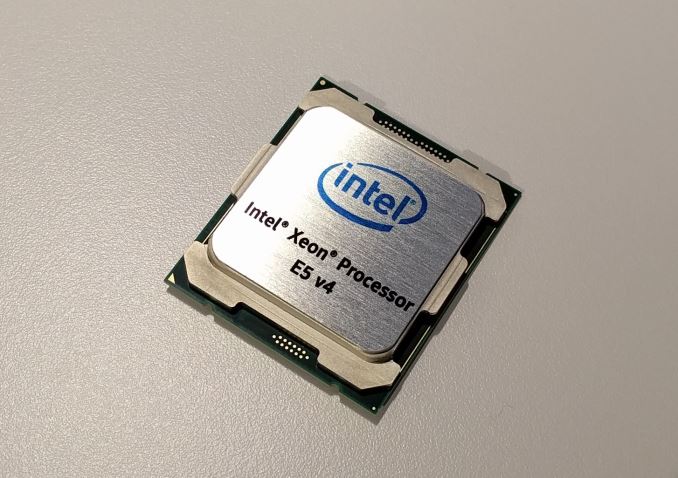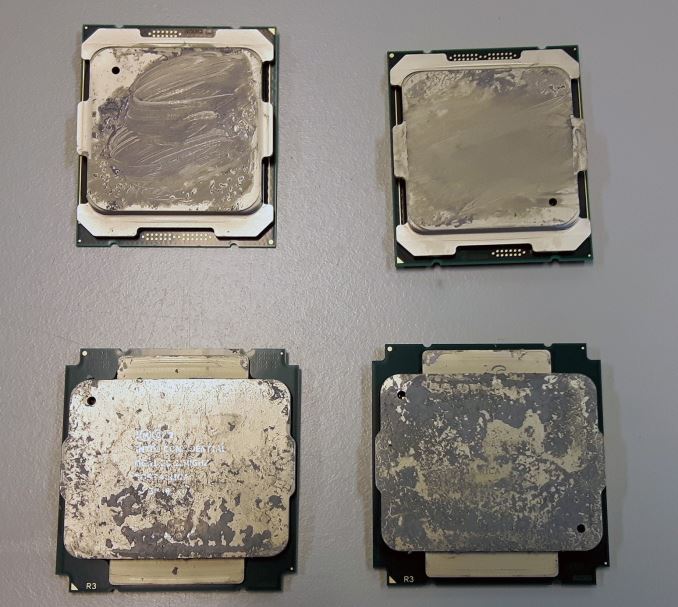The Intel Xeon E5 v4 Review: Testing Broadwell-EP With Demanding Server Workloads
by Johan De Gelas on March 31, 2016 12:30 PM EST- Posted in
- CPUs
- Intel
- Xeon
- Enterprise
- Enterprise CPUs
- Broadwell

We have been spoiled. Since the introduction of the Xeon "Nehalem" 5500 (Xeon 5500, March 2009), Intel has been increasing the core counts of their Xeon CPUs by nearly 50% almost every 18 months. We went from four to six (Xeon 5600) on June 2010. Sandy Bridge (Xeon E5-2600, March 2012) increased the core count to 8. That is only 33% more cores, but each core was substantially faster than the previous generation. Ivy Bridge EP (Xeon E5-2600 v2, launched September 2013) increased the core count from 8 to 12, the Haswell-EP (Xeon E5-2600 v3, sept 2014) surprised with an 18-core flagship SKU.
However it could not go on forever. Sooner or later Intel would need to slow down a bit on adding cores, for both power and space reasons, and today Intel has finally pumped the brakes a bit.
Launching today is the latest generation of Intel's Xeon E5 processors, the Xeon E5 v4 series.Fifteen months after Intel's Broadwell architecture and 14nm process first reached consumers, Broadwell has finally reached the multi-socket server space with Broadwell-EP. Like past EP cores, Broadwell-EP is the bigger, badder sibling of the consumer Broadwell parts, offering more cores, more memory bandwidth, more cache, and more server-focused features. And thanks to the jump from their 22nm process to their current-generation 14nm process, Intel gets to reap the benefits of a smaller, denser process.
Getting back to our discussion of core counts then, even with the jump to 14nm, Intel has played it more conservatively with their core counts. Compared to the Xeon E5 v3 (Haswell-EP), Xeon E5 v4 (Broadwell-EP) makes a smaller jump, going from 18 cores to 24 cores, for an increase of 33%. Yet even then, for the new Xeon E5 v4 "only" 22 cores are activated, so we won't get to see everything Broadwell-EP is capable of right away.
Meanwhile the highest (turbo) clockspeed is still 3.6 GHz, base clocks are reduced with one or two steps and the core improvements are very modest (+5%). Consequently, performance wise, this is probably the least spectacular product refresh we have seen in many years.
But there are still enough paper specs that make the Broadwell version of the Xeon E5 attractive. It finds a home in the same LGA 2011-3 socket. Few people will in-place upgrade from Xeon E5 v3s to Xeon E5 v4s, but using the same platform means less costs for the server vendors, and more software maturity (drivers etc.) for the buyers.

They look very different but fit in the same socket: Xeon E5 v4 on top, Xeon E5 v3 at the bottom
Broadwell also has several features that make it a more attractive processor for virtualized servers. Finer granular control over how applications share the uncore (caches and memory bandwidth) to avoid scenarios where low priority applications slow down high priority ones. Meanwhile quite a few improvements have been made to make the I/O intensive applications run smoother on top of a virtualized layer. Most businesses run their applications virtualized and virtualization is still the key ingredient of the fast growing cloud services (Amazon, Digital Ocean, Azure...), and more and more telecom operators are starting to virtualized their services, so these new features will definitely be put to good use. And of course, Intel made quite a few subtle - but worth talking about - tweaks to keep the HPC (mostly "simulation" and "scientific calculation software) crowd happy.
But don't make the mistake to think that only virtualization and HPC are the only candidates for the new up-to-22-cores Xeons. The newest generation of data analytics frameworks have made enormous performance steps forward by widening the network and storage bandwidth bottlenecks. One example is Apache Spark, which can crunch through terabytes of data much more efficiently than its grandparent Hadoop by making better use of RAM. To get results out of a massive hump of text data, for example, you can use some of most advanced statistical and machine learning algorithms. Mix machine learning with data mining and you get an application that is incredibly CPU-hungry but does not need the latest and fastest NVMe-based SSDs to keep the CPU busy.
Yes, we are proud to present our new benchmark based upon Apache Spark in this review. Combining analytics software with machine learning to get deeper insights is one of the most exciting trends in the enterprise world. And it is also one of the reason why even a 22-core Broadwell is still not fast enough.










112 Comments
View All Comments
Kevin G - Thursday, March 31, 2016 - link
Much like how Apple skipped Haswell-EP, they also skipped a generation of cards from AMD and nVidia. So even if Apple doesn't wait for new GPUs, their is certainly an update on the GPU side.The more interesting possibility would be if Apple were to go with Xeon D in the Mac Pro instead of Broadwell-EP. Apple would need a big PLX chip considering the number of lanes they's want to use but it is possible.
bill.rookard - Thursday, March 31, 2016 - link
Another issue is that they're not under any pressure from any competition to really innovate. I don't even remember the last time I read anything about Opteron servers... let alone something about any NEW Opterons.ComputerGuy2006 - Thursday, March 31, 2016 - link
A sign of things to come for Broadwell-e?Seems like a tricky situation. Because skylake-e will come with a new platform in 2017, while broadwell-e isn't the fastest IPC and there are crazy rumors it will might cost $1500 (lol Intel). We also have Zen later this year that might give good performance with good cost/perf ratio.
extide - Thursday, March 31, 2016 - link
Yeah so Intel only gives us the LCC part for the -E platform, so we will see the 10-core SKU as the top, It will either be $1000, or $1500 ... so yeah not sure how that will end up. Although there will be 8 and 6 core options that should be pretty affordable.Hopefully they do an 8 core part with 28 lanes for under $500, as THAT would be a great deal!
dragonsqrrl - Sunday, April 3, 2016 - link
I'm hoping the 8 core SKU is around $600, the position the x930K traditionally occupies. What makes me a little worried is that there will be 4 SKUs instead of 3 this time (one 10 core, one 8 core, and two 6 core), and I'm not sure there's enough room under the $600 price point for two 6 core processors.jasonelmore - Thursday, March 31, 2016 - link
Can it run Star Citizen?theduckofdeath - Thursday, March 31, 2016 - link
A question we'll never get an answer to? :DJohanAnandtech - Friday, April 1, 2016 - link
It probably runs mostly on Xeons. Well, the back end that is :-)extide - Thursday, March 31, 2016 - link
BOOM, 454mm^2 on the worlds best process. The "other" 14/16nm processes use bigger geometry than Intel's 14nm process.Now we just need those other guys to catch up so we can see 450+mm GPU's!
Kevin G - Thursday, March 31, 2016 - link
Intel still has plenty of room to increase die size. The largest chip they've produced was the Tukwila Itanium 2 at 699 mm^2. Granted that was a 65 nm design but Haswell-EX is a juggarnaught at 662 mm^2 on Intel's more recent 22 nm process. Seems reasonable that SkyLake-EX could go to 32 cores as Intel has >200 mm^2 of rectal limit left.As for GPU's, they're also huge. nVidia's GM200 is 601 mm^2 and AMD's Fiji is 'only' 596 mm^2 both on 28 nm process. TSMC's 20 nm process was skipped so even using the looser 16 nm FinFET, GPU's will see a significant shrink compared to the those high end chips.